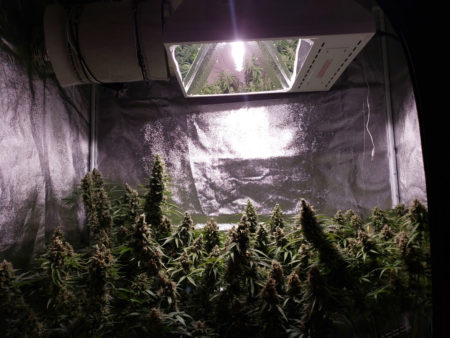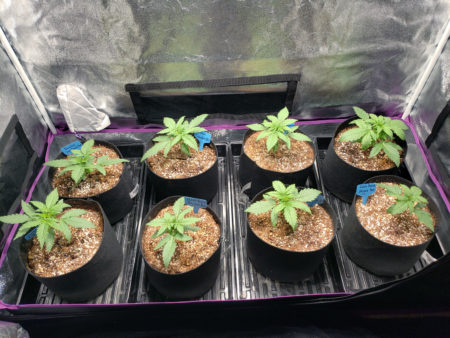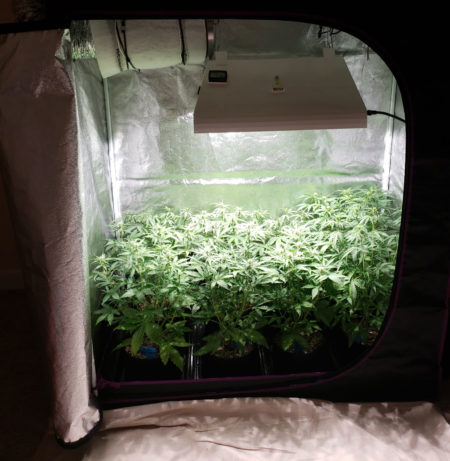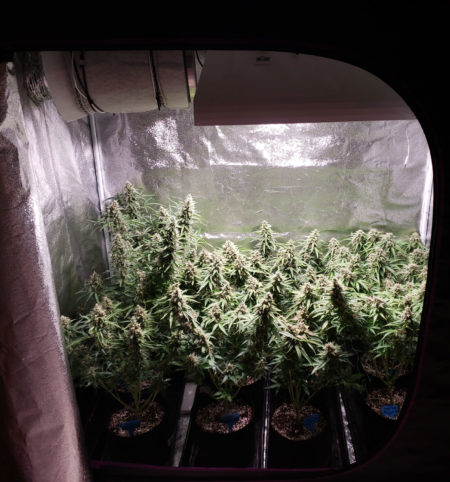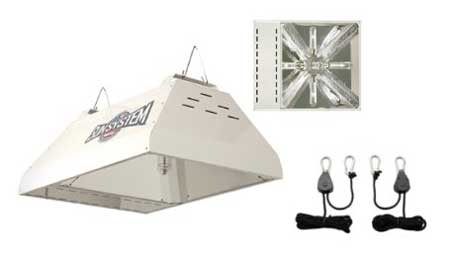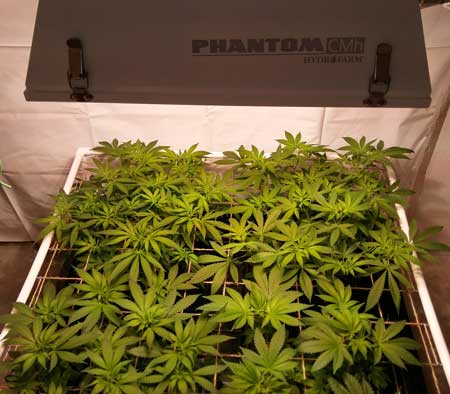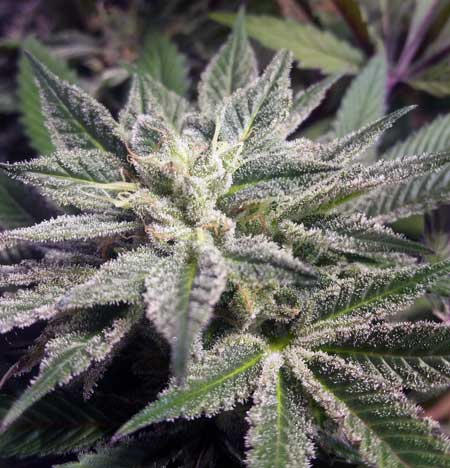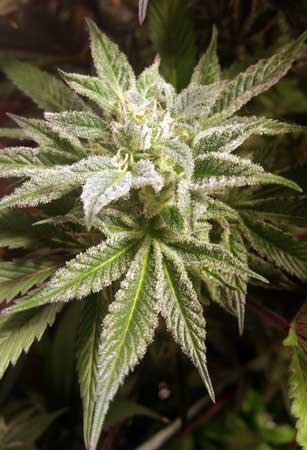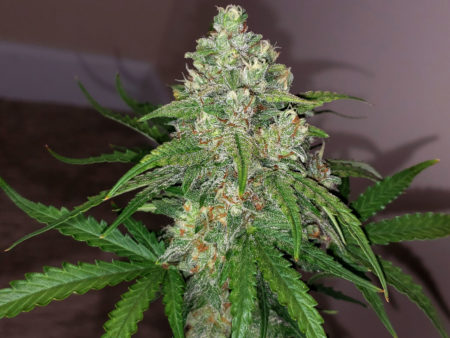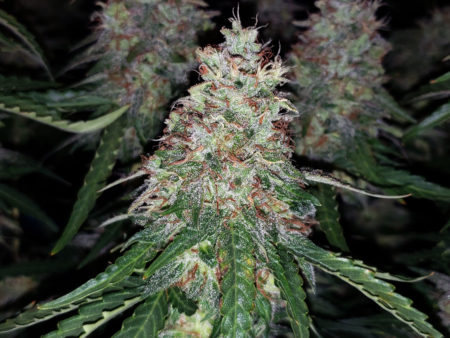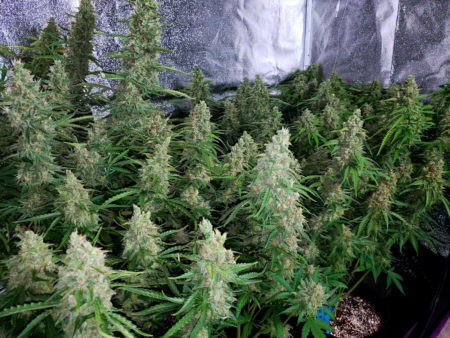by Nebula Haze
What is an LEC grow light? The first time I saw one of these labeled as a “LEC grow light” was in a hydroponic grow store in late 2015.
This grow light goes by both “LEC” and “CMH”. Both terms refer to the same kind of light. “LEC” just is a brand name for the particular CMH produced by the company Sun System.
At the time, the clerk at the store told me that LEC stands for “Light Emitting Ceramic” but even the clerk wasn’t exactly sure what made it better than other grow lights. However, he told me that LECs were far better than any LED grow lights, and that LEC grow lights were going to be the wave of the future.
Talk about piquing my interest!
An LEC grow light can be used throughout a plant’s life from seed to harvest. These plants spent their entire lives under a 315 LEC grow light.
What is a LEC grow light?
LEC grow lights operate a lot like a regular metal halide (MH) grow light except instead of using quartz they use a ceramic arc tube, very similar to what’s used in HPS grow lights. This is why they’re often called “ceramic metal halides,” and they have some distinct advantages! Compared to regular MH bulbs, LEC lights give off a more natural color, produce more light per watt, and last longer.
I know it can be confusing but I’ll try to help clear up all the terms that talk about Ceramic Metal Halide grow lights for growing cannabis:
- “LEC” and “CMH” both refer to Ceramic Metal Halide grow lights.
- Ceramic Metal Halide (CMH) – Metal Halide light that uses a ceramic arc tube like an HPS
- Ceramic Discharge Metal Halide (CDM) – Different term for the same technology
- Light Emitting Ceramic (LEC) grow light – “LEC” is a brand name (trademark) for a model of grow light that uses ceramic metal halide technology. However, the term “LEC” is starting to become interchangeable with the term Ceramic Metal Halide (CMH) since they’re both referring to the same technology.
It’s more common to see these called CMH grow lights, but LEC is starting to become a lot more popular, probably because it’s reminiscent of “LED” grow lights which have been hailed as the grow light of the future, until now!
The LEC 315 model is currently the most common size LEC grow light and yields about 5-10 ounces on average (though some growers get even more, here’s a tutorial on how to yield a pound with one!)
315W LEC grow lights are kept about 18″ from the tops of plants. If possible, choose “4200K” color bulbs to see your plants in their best color.
This style of grow light is becoming increasingly popular for indoor marijuana growers. When it comes to growing cannabis, what advantages do LEC grow lights have over traditional grow lights?
- Ceramic metal halide lights produce UV-B rays, like the sun. This may be contributing to increased trichome development and smell in cannabis buds grown under LECs. However, UV-B rays get blocked by glass, so there needs to be a clear path between the plant and the light for this to be effective. Also always wear protective glasses that block UV light so you don’t damage your eyes!
- LEC grow lights do not produce radio interference (which can interfere with AM radios and otherwise alert people to your grow)
- LECs produce a natural spectrum of light that lets you see your plants in full color. Unlike grow lights which produce purple (LED) or yellow (HPS) light, the light from an LEC typically won’t distort the color of your plants. Not only is it just plain nice to be able to really see your garden in all its vibrancy, having natural colored light also makes it a lot easier to diagnose problems which can sometimes go unnoticed under unnatural colored grow lights. An LEC is also much less suspicious looking if light accidentally spills out a window. If given a choice for bulb color, I recommend getting “4200K” color bulbs as they give great results and let your see your plants the best.
- Many LEC grow light models come with a built-in ballast which makes them “plug-and-play” (you plug the light directly into the wall) like an LED, as opposed to most HID grow lights which need a separate ballast
- LEC bulbs last longer and keep their brightness for longer than regular MH grow lights, so bulbs don’t need to be replaced as often.
Increased trichome production under LEC Grow Lights?
LEC grown cannabis bud pic by the talented grower Jamie Arellano
What disadvantages do LEC grow lights have over traditional grow lights?
- Unfortunately, LEC grow lights don’t quite get the same yields as HPS grow lights of similar wattage when used as the primary light in the flowering stage. However, they do get significantly higher yields than a similar wattage Metal Halide bulb would get in the flowering stage, as well as all the added benefits as stated in this article!
- Price – LEC grow lights have a pretty high initial cost, starting around $380 for the smallest size. However, the bulbs last far longer than a typical HPS bulb so you won’t need to buy anything else for several grows.
Another example of LEC-grown cannabis buds – sparkly!
LEC marijuana bud pic by Jamie Arellano
More examples of cannabis buds grown under a 315 LEC from seed to harvest
How Far Away Do you Keep LEC Grow Lights From Your Plants?
When it comes to distance, LEC grow lights produce an extremely powerful light and typically need to be kept further away from your plants than MH or HPS grow lights of a similar wattage.
Sun System Models
| LEC Grow Light Wattage | Distance From Plant |
| 315W | 18-20″ (45-51cm) or more |
| 630W | 24-26″ (60-66cm) or more |
*Keep LEC grow lights an extra 6-12″ (15-30cm) away for young plants until they’re a few weeks old, or if you see signs of light stress.
For other CMH Models always check with the manufacturer’s specifications, as some of the non-Sun System models need to be kept as far as 3 feet away from the tops of your plants. Here are some examples where I found the recommended distance:
- Grower’s Choice 315W CMH – 2.5-3 feet (76-91 cm) from plants
- Hortilux 315W CMH – 3 feet (91 cm) from plants
- Vivosun 315 CMH – 24 inches (60 cm) from plants
As with any grow light, always conduct the 30-second “hand test” after you’ve positioned your light. If the light/heat bothers your hand after 30 seconds, it may bother your plants!
Keep 315 LEC grow lights about 18 inches (45 cm) away from the tops of your cannabis plants for the best results. The larger 630 LEC grow lights should be kept at least 24″ (60 cm) away or further.
Quick Reference for Grow Light Efficiency
(how much light produced initially compared to electricity for the most common cannabis grow lights)
- CFLs – 50-70 lumens/watt
- Standard MH – 80-90 lumens/watt
- CMH / LEC – 90-105 lumens/watt
- HPS – 105-150 lumens/watt
- LED (unfortunately lumens aren’t a good measure of LED brightness)
LEC Grow Lights Produce UV-B Light
On the spectrum of light, UV-B is below blue/violet (that’s why it’s called “ultra-violet”) and outside of our range of vision. However, even though we can’t see UV-B light, it still has a big effect on both humans and plants!
But it’s not just any kind of light, UV-B light is bad for humans (we use sunscreen to protect ourselves from UV light from the sun) and can actually hurt plants, too. In fact, we believe trichomes may help protect the plant from UV-B rays, kind of like how humans get a tan.
This could be why increasing UV-B exposure seems to increase trichome production. However, because of the danger of UV-B light, always make sure to protect yourself and your skin from exposure and never look directly at the light! It’s a great idea to always wear protective glasses that block UV light so you don’t damage your eyes.
Supplementing your flowering plant with UV-B light using a LEC grow lights may increase the potency and smell production by triggering a natural stress response!
However, glass blocks UV-B light, so if using an LEC grow light, you will get the best results by making sure there is a clear path from the light to your plants!
Learn more about…
Jump to…
More Info on Cannabis Grow Lights
How Long Does it Take to Grow Cannabis?
10-Step Guide to Getting Started Growing Cannabis
How to fix 99% of cannabis plant problems

